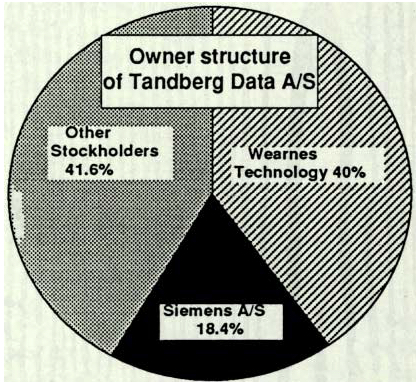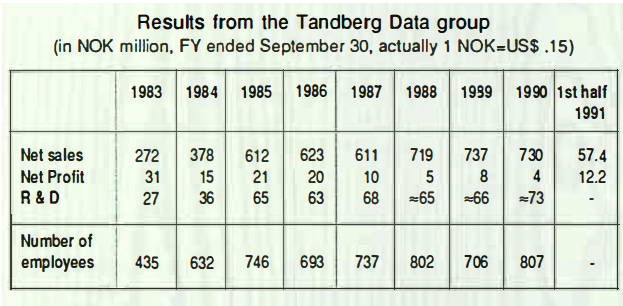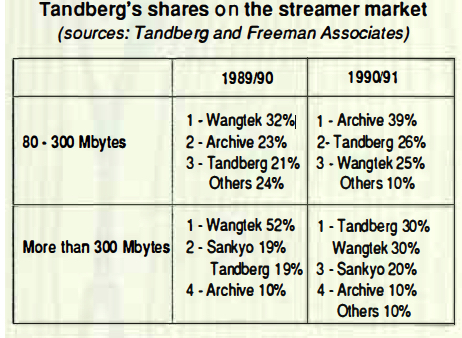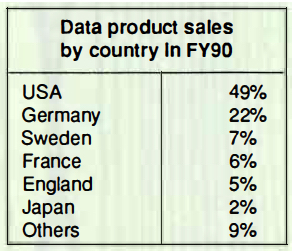History (1991): Tandberg Motto Being QIC Only
Not DAT
By Jean Jacques Maleval | February 3, 2020 at 2:23 pmTandberg Data (Oslo, Norway), the unique European tape unit manufacturer, is also the only large producer of data cartridge streamers that is completely betting on QIC drives and refuses to get involved in DATs.
It has been quite successful these last few months with large OEMs, DEC and IBM ahead.
The last major event was the entry of Singapore people in the Viking’s capital, and this on account of the withdrawal of a German company, Siemens.
Tandberg’s name is still related to its excellent audio tape recorders. But the company sunk, as it no longer could keep up with the Japanese at the end of the 70’s, but reappeared afterwards in the computer segment.
And curiously, its first success didn’t come from storage units but from manufacturing and selling high quality ergonomic terminals and screens. But here again, competition was severe.
And since 1988, sales of streamers definitely surpassed those of display products. The last past months were very positive for Tandberg with its cartridge drives becoming quite successful.
Is it a flash in the pan? In the storage industry, big OEMs easily switch from one supplier to another. You always have to have one product ahead of other competitors. And in this segment, competition from DATs is beginning to appear.
There is another uncertain question for the Norwegian company. What will be the policy of its new main shareholder, Wearnes, that replaced Siemens? Will it be willing to invest into a company where profitability, has continuously dropped in the last 5 years, but has exceptionally improved these past 9 months? These are the unknown points that will have to face Tandberg’s new president and CEO Arne Ramstad who has replaced Hans Lodrup that left for Siemens AS (Oslo) on April 30.

From audio to data processing Tandberg Data was established in March 1979 on the ashes of Tandberg Radiofabrik AS, that was a leading manufacturer of audio tape devices, after a bankrupt and the suicide of its founder, Mr. Tandberg.
But there already was a data division since 1972, and its first product, the TDC 3000, a start/stop reel-to-reel tape drive, is still sold today.

The first quarter-inch cartridge streamers were launched in 1982.
In last FY, ended September 30, 1990, the Tandberg group reported a turnover of NOK730 million, equivalent to $124 million, a 1% drop compared with 1989. Net profits fell from NOK8 million to only NOK4 million at the same time.


There are several reasons for 1990’s poor results. Curiously, they didn’t come from the sales of terminals that increased 23%, when they had been continuously dropping since 1986. The main explanation should be searched in the storage division with the delays in producing the 525 MB TDC 3800 streamer.
Another major reason is Siemens’ withdrawal. Distribution subsidiaries, handled by the German computer manufacturer did not reach expectations. The US one started over from scratch and was completely taken over by Tandberg. Sales in the German one dropped, and its losses increased as much. These poor results could only have a negative effect on a group where streamer exports account for 98% of its sales.
“Only 200 units are sold in Norway each year,” says Egil Nord, VP sales and marketing, storage division.
No. 500,000
Future looks better, especially with the huge current shipments to IBM and DEC. Nord expects a 220,000 drive production this year from 122,000 in FY90.

“Actually, we have a 45,000 streamer output each quarter, and we are going to produce 55,000.” And he proudly adds “On Tuesday an over 20% increase.”
In the first semester, ended March 31, 1991, the group reported NOK507.4 million sales and NOK12.2 million profits before extraordinary profit and tax, compared with 312.6 million and 2.3 million loss respectively in the first 6 months of FY90. Storage business represented 54% of the sales of the mother company in this first FY91 semester, with a revenue growth of 42% compared to the previous period.
Production’s target: ISO 9001 certification
The company owns 2 manufacturing plants in Oslo’s suburbs, the first one on 162,000 square feet in Kjelsas, the other on 13,200 square feet in Lorenskog, but all the production is scheduled to be moved to the first site in the future. The goal is to achieve a 5 Sigma quality (maximum 3.4 errors per 1 million transaction/units) for all products during 1996 and the manufacturing division will aim at attaining ISO 9001 certification during 1991.
The two big manufacturing principles of the company are SPC (Statistical Process Control) and JIT (Just In Time material flow management), with a very sophisticated computerized system that controls each point of the production on a large local network.
Wearnes replaces Siemens
The big event at Tandberg’s these last months is Wearnes Technology’s entry as main shareholder in summer 90. Siemens A/S, who owned 58.4% of the company, is now ahead of only 18.4% of the shares and has sold 40% to Wearnes for an estimated amount of NOK65 million. Chun Win Wong and Chris Yong, respectively CEO and GM of Wearnes Technology, entered Tandberg’s board.
In the terms of the agreement, Siemens has the right to make Wearnes buy the remaining 18.4% in the next two years, but on its side, the Singapore company can sell its 40% in the same laps of time.
The agreement, ratified by the Norwegian government, obliges Wearnes in keeping the production in Norway. The Singapore group is already largely involved in data processing (see framed box above) and is trying to acquire all the knowledge necessary to manufacture all the parts of a microcomputer. When Nixdorf was bought back by Siemens, this last one decided to discontinue storage peripherals that were no longer profitable.
First Wearnes, partly owner of Microscience, acquired the rights on Siemens line of high capacity MegaFile HDDs. And then, when the German firm tried to get rid of Tandberg, Wearnes was number one on the list.
Until now, Wearnes executives have been very discreet on their projects on Tandberg.
“They only came three times,” says Nord.
And for the anecdote, he said that one of Wearnes executives, who, when he was younger, didn’t have enough money to buy one of Tandberg’s famous audio tape recorder, was very proud to be able to afford buying the entire company.
Tandberg is going to produce DC2000 cartridge drives
The largest part of today’s production is two 5.25-inch half-height QIC drives on DC6000 cartridges, the TDC 3600 with a 60 to 150MB capacities (250,000 sold at the end of September 1990) and the TDC 3800, now in production that can store 525MB.
As of September 1991, the production of the 1GB TDC 4100, already announced, will begin. It should cost from $500 to $600 in large OEM quantities.
On this occasion, and for the first time, an evident dissension appeared among QIC Drive Standards members, with two different standards adopted, the QIC 1000 and the QIC 1350, for very similar products since their capacities reach 1 and 1.3GB respectively.
Like Sankyo and Wangtek, the Norwegian company doesn’t want to hear about the QIC 1350 adopted by Archive, for this standard implies too many changes from the QIC 525 and doesn’t allow a sufficient compatibility with former OIC drives.
Tandberg, one of the founders of the QIC in 1982, and one of its most active member, has no intention to drop it however, on the contrary.
“We are determined to stay with the QIC technology and to improve it in the years to come, mainly by relying on the worldwide actual population of close to 6 million compatible QIC units.”
The Oslo company, by taking Freeman Associates statistics as a basis, claims to represent 24% of the QIC 525 worldwide market, and even 80% in Germany, 60% in Europe, more than 50% in Japan but only about 10% in the US.

Afterwards, the 1GB TOC 4100 will come with a data compression system. It will offer an effective sustained rate of 300 to 800KB/s at 53.3ips, 450KB/s to 1.2MB/s at 80ips, with an average capacity of 2 or 2.6GB depending on the length of the tape, 760 or 1,020 feet. Later, Tandberg plans to switch to the 6GB QIC 6000 (12GB with data compression).
Actually, the DC 3800 has 26 tracks.
“In 1993, we expect to reach 96 data tracks and 16 servo tracks,” says a spokesman in Oslo.
Tandberg also announced its intention to produce 3.5-inch drives for DC2000 cartridges, once more to compete more closely with 4mm DAT drives.
“We will announce in 1992, at summer time, a drive that will store directly 2GB on a 1,020-foot and 900 oersted barium ferrite tape. It will cost from $300 to $500 in large OEM volumes. Then we will switch to 4GB formatted or 8GB with compression,” says Nord.
To develop its sales, Tandberg asked its French subsidiary to produce subsystems, the Panther line.
Its 400 different references of backup systems based on the TDC 3600 et 3800, including a controller board and an application software, Sytos Plus. Models are available for DOS, OS/2, Macintosh, Xenix, Unix, Prologue, Novell and LAN Manager networks, etc.
Four subsidiaries
Since Siemens had decided to discontinue its own disk and tape activities in Germany, Tandberg had to buy back, on September 30, 1990 the 50% shares of its partner Tandberg Data GmbH (Dortmund), now a wholly-owned subsidiary of Tandberg Data NS. FY90 was a poor year for the German branch that reported a drop in sales from NOK263 to NOK242 million (with 40% in streamer sales), and results before tax amounted to a loss of NOK2 million vs. the previous year’s plus NOK11.8 million. The subsidiary achieved sales amounting to NOK88 million in the first half of FY91. The result before extraordinary items, NOK2.7 million, was negative but weaker than anticipated.

Tandberg Data GmbH, that employs 65 persons, covers Austria, Germany, Switzerland and The Netherlands, and is helped by a sales office of Wearnes Technology in Bremen. In the US, Siemens was completely in charge of distributing Tandberg products until July 1990 when Tandberg Data Inc. (Westlake Village, CA), a wholly-owned subsidiary of the Norwegian group that employs 18 people was set up.
Americans are the first customers of the group with 49% of the streamer sales, but these include OEM contracts directly signed between Oslo and US computer manufacturers.
In 1989, Siemens Information Systems Inc. (Newbury Park, CA) was the third customer of storage products for Tandberg after IBM and the German subsidiary Tandberg Data GmbH.
In the first half of 1991, the US subsidiary reached a turnover of NOK33.6 million and showed a small positive result.
According to Arnaud Servole, sales manager of Tandberg Data SA (Vélizy, France), the French subsidiary counted 8 persons in 1990 and reported FF32 million (NOK36 million) sales. The tape units counted for 78%. The target this year is to employ 12 persons and to reach sales of FF55 to FF60 million. The first half 91 ended with NOK27.8 million sales and a result of NOK2.1 million. Expected improvement is on account of the French subsidiary being now in charge of all Panther subsystems worldwide based on QIC cartridge units.
Until 1987, Tandberg manufactured in Brittany TDV 2200S terminals that had then been a success but no longer are.
The Oslo mother company only owns 37.5% of its English distributor, Farnell-Tandberg Data Ltd. in Wetherby, the remaining being held by Farnell International Instruments.
From FY89 to FY90, sales of Farnell (18 persons) dropped from NOK53 to 45 million.
Here is a list of official worldwide distributors of Tandberg:
– Australia: Wollongong Computing Sciences
– Denmark: Data Visual
– Finland: Gadelius OY, Tahonic OY
– France: Alfatronic, Axel, HCC, Metrologie, Tekelec-Airtronic, Toplog
– Germany: REIN Elektronik, Technitron
– Italy: Euro.com
– Japan: Siemens KK
– Korea: Samsung
– Norway: Tallgrass Technologies
– Singapore: Mumps Systems Support
– Spain: Comelta
– Sweden: Gadelius Elektronik AB
– UK: Metro UK, Northamber
– USA: Marshall Industries, EI Monte, CA
Wearnes: Singapore group close to one half billion dollars
Tandberg’s main shareholder, Wearnes Technology (Private) Ltd., is a wholly-owned subsidiary company of Wearne Brothers Ltd., where the OverseaChinese Banking Corporation (OCBC) of Singapore owns 27.4%.
As a public company, Wearne Brothers began in 1912. However it traces its history to a family automotive business in the early 1900’s.
Today, it is an internationally diversified group. Its activities are divided in four parts: automotive and industrial equipment (distribution of vehicles like Jaguar, Rolls-Royce, Bentley and Daimler for instance); technology and manufacturing, trading and distribution, leisure and properties (the group owns several golf courses).
On December 31, 1990, Wearnes Brothers reported sales of 836 million Singapore dollars (1US$ = 1.8SDR), a 49% increase compared with the previous year, with profits before tax of SDR52 millions.
Its subsidiary Wearnes Technology (Pte) Ltd. is an investment holding, and owns 40% of Tandberg.
In other computer businesses, the Wearnes group owns:
– 61% of ALR (Advanced Logic Research), one of the top 3 suppliers of EISA-based systems worldwide,
– 59% of Microscience International (Singapore) Ltd. and 20%t of
Microscience International Corp. (USA), an HDD manufacturer,
– 100% of Weltec Digital (USA), specialized in distributing and servicing computer disk drives and modems,
– 16% of Interconnection Products Singapore Pte. Ltd., which manufactures and markets connectors for HDDs and PC applications,
– 41% of New Dest Corp. (USA), manufacturer of document scanners,
– 43% of Systonetics Inc. (USA), computer software developer.
Wearne’s strategy is clear: to acquire little by little all the knowledge in the microcomputer sector and at every level: components, peripherals, software.
As of right now, the combined capabilities of its plants in Singapore, Malaysia, Indonesia, China, Hong Kong, Taiwan, USA, UK and Norway, can produce all the parts and components of a PC except for the fabrication of wafers.
This article is an abstract of news published on the former paper version of Computer Data Storage Newsletter on issue ≠40, published on May 1991.









 Subscribe to our free daily newsletter
Subscribe to our free daily newsletter

